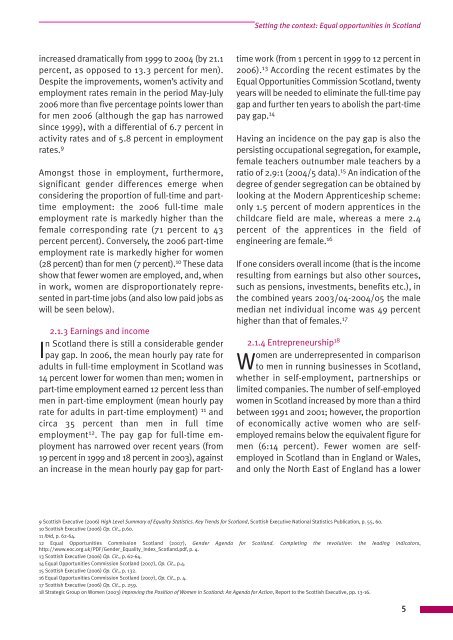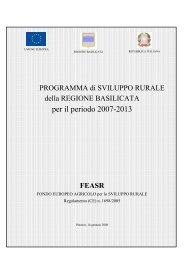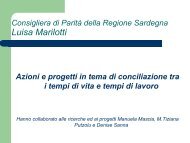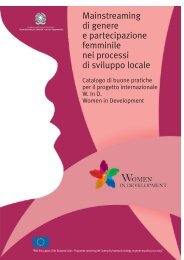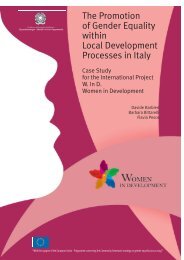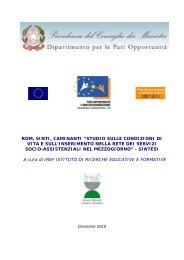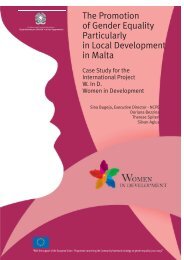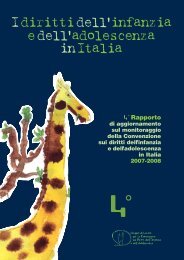3 CASO SCOZIA INGLESE low - Rete Pari Opportunita
3 CASO SCOZIA INGLESE low - Rete Pari Opportunita
3 CASO SCOZIA INGLESE low - Rete Pari Opportunita
- No tags were found...
Create successful ePaper yourself
Turn your PDF publications into a flip-book with our unique Google optimized e-Paper software.
Setting the context: Equal opportunities in Scotlandincreased dramatically from 1999 to 2004 (by 21.1percent, as opposed to 13.3 percent for men).Despite the improvements, women’s activity andemployment rates remain in the period May-July2006 more than five percentage points <strong>low</strong>er thanfor men 2006 (although the gap has narrowedsince 1999), with a differential of 6.7 percent inactivity rates and of 5.8 percent in employmentrates. 9Amongst those in employment, furthermore,significant gender differences emerge whenconsidering the proportion of full-time and parttimeemployment: the 2006 full-time maleemployment rate is markedly higher than thefemale corresponding rate (71 percent to 43percent percent). Conversely, the 2006 part-timeemployment rate is markedly higher for women(28 percent) than for men (7 percent). 10 These datashow that fewer women are employed, and, whenin work, women are disproportionately representedin part-time jobs (and also <strong>low</strong> paid jobs aswill be seen be<strong>low</strong>).2.1.3 Earnings and incomeIn Scotland there is still a considerable genderpay gap. In 2006, the mean hourly pay rate foradults in full-time employment in Scotland was14 percent <strong>low</strong>er for women than men; women inpart-time employment earned 12 percent less thanmen in part-time employment (mean hourly payrate for adults in part-time employment) 11 andcirca 35 percent than men in full timeemployment 12 . The pay gap for full-time employmenthas narrowed over recent years (from19 percent in 1999 and 18 percent in 2003), againstan increase in the mean hourly pay gap for parttimework (from 1 percent in 1999 to 12 percent in2006). 13 According the recent estimates by theEqual Opportunities Commission Scotland, twentyyears will be needed to eliminate the full-time paygap and further ten years to abolish the part-timepay gap. 14Having an incidence on the pay gap is also thepersisting occupational segregation, for example,female teachers outnumber male teachers by aratio of 2.9:1 (2004/5 data). 15 An indication of thedegree of gender segregation can be obtained bylooking at the Modern Apprenticeship scheme:only 1.5 percent of modern apprentices in thechildcare field are male, whereas a mere 2.4percent of the apprentices in the field ofengineering are female. 16If one considers overall income (that is the incomeresulting from earnings but also other sources,such as pensions, investments, benefits etc.), inthe combined years 2003/04-2004/05 the malemedian net individual income was 49 percenthigher than that of females. 172.1.4 Entrepreneurship 18Women are underrepresented in comparisonto men in running businesses in Scotland,whether in self-employment, partnerships orlimited companies. The number of self-employedwomen in Scotland increased by more than a thirdbetween 1991 and 2001; however, the proportionof economically active women who are selfemployedremains be<strong>low</strong> the equivalent figure formen (6:14 percent). Fewer women are selfemployedin Scotland than in England or Wales,and only the North East of England has a <strong>low</strong>er9 Scottish Executive (2006) High Level Summary of Equality Statistics. Key Trends for Scotland, Scottish Executive National Statistics Publication, p. 55, 60.10 Scottish Executive (2006) Op. Cit., p.60.11 Ibid, p. 62-64.12 Equal Opportunities Commission Scotland (2007), Gender Agenda for Scotland. Completing the revolution: the leading indicators,http://www.eoc.org.uk/PDF/Gender_Equality_Index_Scotland.pdf, p. 4.13 Scottish Executive (2006) Op. Cit., p. 62-64.14 Equal Opportunities Commission Scotland (2007), Op. Cit.,p.4.15 Scottish Executive (2006) Op. Cit., p. 132.16 Equal Opportunities Commission Scotland (2007), Op. Cit.,p.4.17 Scottish Executive (2006) Op. Cit., p. 259.18 Strategic Group on Women (2003) Improving the Position of Women in Scotland: An Agenda for Action, Report to the Scottish Executive, pp. 13-16.5


